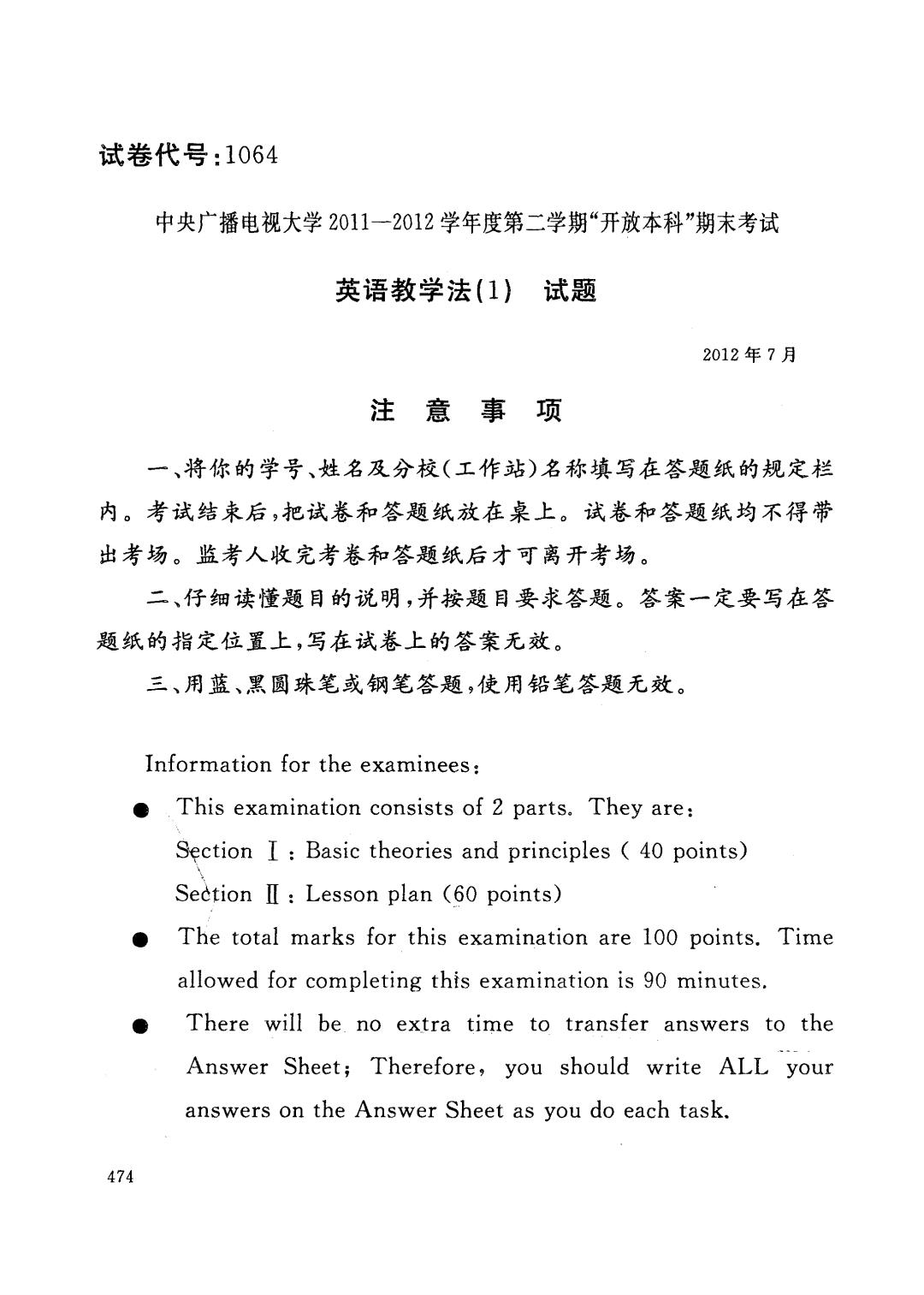
试卷代号:1064 中央广播电视大学2011一2012学年度第二学期“开放本科”期末考试 英语教学法(1)试题 2012年7月 注意事项 一、将你的学号、姓名及分校(工作站)名称填写在答题纸的规定栏 内。考试结束后,把试卷和答题纸放在桌上。试卷和答题纸均不得带 出考场。监考人收完考卷和答题纸后才可离开考场。 二、仔细读懂题目的说明,并按题目要求答题。答案一定要写在答 题纸的指定位置上,写在试卷上的答案无效。 三、用蓝、黑圆珠笔或钢笔答题,使用铅笔答题无效。 Information for the examinees: This examination consists of 2 parts.They are: Section I:Basic theories and principles 40 points) SectionⅡ:Lesson plan(60 points) The total marks for this examination are 100 points.Time allowed for completing this examination is 90 minutes. There will be no extra time to transfer answers to the Answer Sheet;Therefore,you should write ALL your answers on the Answer Sheet as you do each task. 474
试卷代号 中央广播电视大学 11 2012 年度第二 开放本科 未考试 英语教学法( 1)试题 2012 年7 注意事项 、将你的学号、姓名及分校(工作站)名称填写在答题纸的规定栏 内。考试结束后,把试卷和答题纸放在桌上。试卷和答题纸均不得带 出考场。监考人收完考卷和答题纸后才可离开考场。 二、仔细读懂题目的说明,并按题目要求答题。答案一定要写在答 题纸的指定位置上,写在试卷上的答案无效。 三、用蓝、黑圆珠笔或钢笔答题,使用铅笔答题无效。 Information for the examinees! • .This examination consists of 2 parts. They are: 8~ction I : Basic theories and principles ( 40 points) Se~tion II : Lesson plan (60 points) • The total marks for this examination are 100 points. Time allowed for completing this examination is 90 minutes. • There will be no extra time to transfer answers to the Answer Sheet; Therefore , you should write ALL your answers on the Answer Sheet as you do each task. 474

Section I Basic Theories and Principles (40 points) Questions 1-20 are based on this part. Directions:Choose the best answer from A,B or C for each question.Write your answer on the Answer Sheet. 1.Which of the following statements about course design is NOT true? A.The general goals of a course should be specified based on the learners'needs. B.The contents of a course should be selected to fit in with the learning experiences. C.The assessment activities should reflect those taught in a course. 2.Which of the following methods does not tolerate errors? A.The Audio-lingual Method. B.The Communicative Approach. C.The Direct Method. 3.What syllabus does the following present? Unit 1 Self-introduction Unit 2 Greetings Unit 3 Asking the way Unit 4 Making apologies Unit 5 Inviting Unit 6 Extending thanks A.Structural syllabus B.Topic syllabus C.Functional syllabus 4.If we compare the learning process to a journey,which of the following is similar to the destination? A.Necessities. B.Lacks. C.Wants. 5.What does the communication approach treat language as? A.A system. B.A means of communication. C.A set of habits. 6.Which of the following is the description of a function? A.Ownership. B.Giving directions. C.Acting out a play. 475
(40 points) B. Topic syllabus Section I Basic Theories and Principles Questions 1-20 are based on this part. Directions: Choose the best answer from A , B or C for each question. Write your answer on the Answer Sheet. 1. Which of the following statements about course design is NOT true? A. The general goals of a course should be specifiedbased on the learners' needs. B. The contents of a course should be selected to fit in with the learning experiences. C. The assessment activities should reflect those taught in a course. 2. Which of the following methods does not tolerate errors? A. The Audio-lingual Method. B. The Communicative Approach. C. The Direct Method. 3. What syllabus does the following present? Unit 1 Self-introduction Unit 2 Greetings Unit 3 Asking the way Unit 4 Making apologies Unit 5 Inviting Unit 6 Extending thanks A. Structural syllabus C. Functional syllabus 4.If we compare the learning process to a journey , which of the following is similar to 民destination? A. ~ecessities. C. Wants. B. Lacks. 5. What does the communication approach treat language as? A. A system. B. A means of communication. C. A set of habits. 6. Which of the following is the description of a function? A. Ownership. C. Acting out a play. B. Giving directions. 475
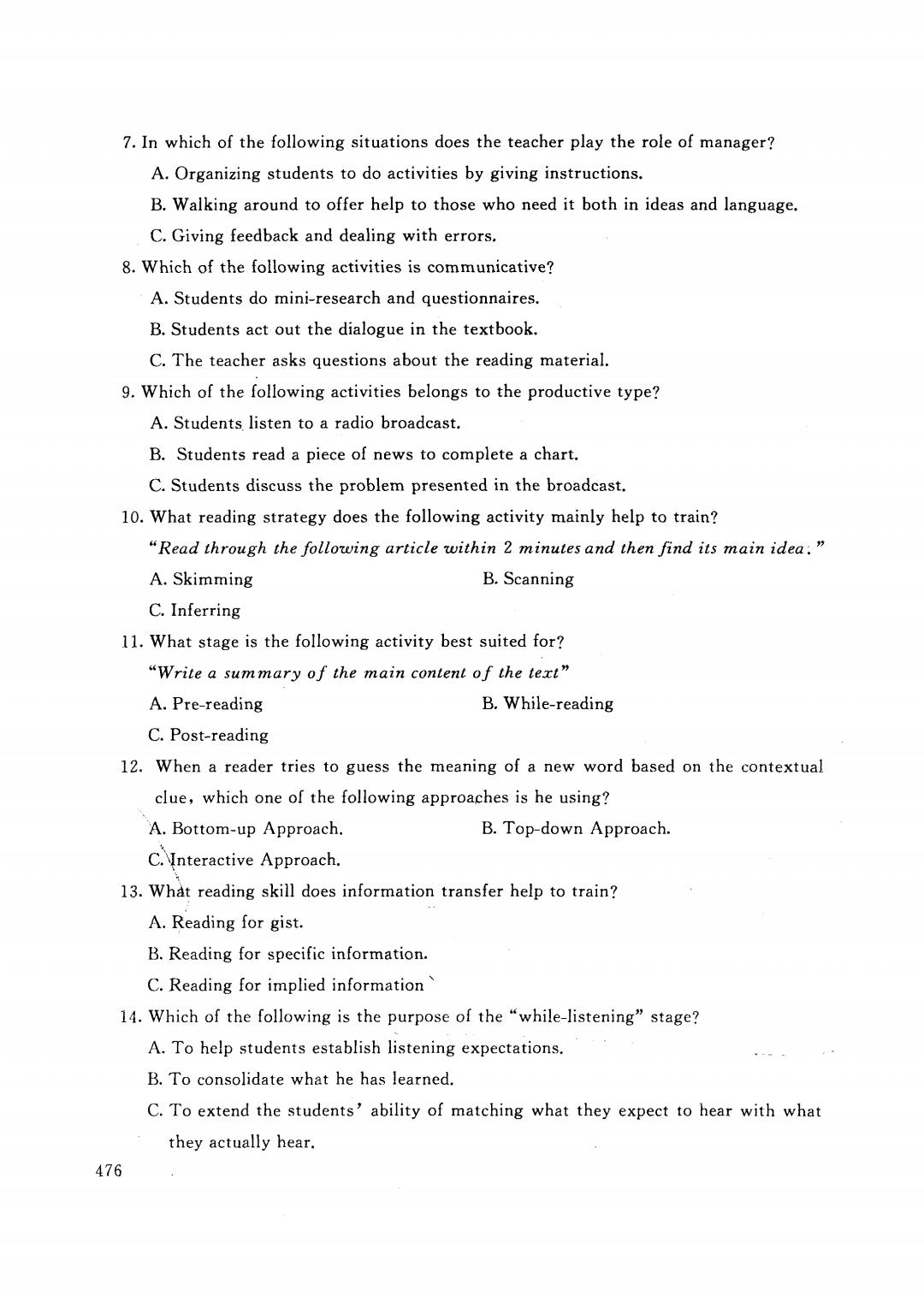
7.In which of the following situations does the teacher play the role of manager? A.Organizing students to do activities by giving instructions. B.Walking around to offer help to those who need it both in ideas and language. C.Giving feedback and dealing with errors. 8.Which of the following activities is communicative? A.Students do mini-research and questionnaires. B.Students act out the dialogue in the textbook. C.The teacher asks questions about the reading material. 9.Which of the following activities belongs to the productive type? A.Students listen to a radio broadcast. B.Students read a piece of news to complete a chart. C.Students discuss the problem presented in the broadcast. 10.What reading strategy does the following activity mainly help to train? "Read through the following article within 2 minutes and then find its main idea." A.Skimming B.Scanning C.Inferring 11.What stage is the following activity best suited for? "Write a summary of the main content of the text" A.Pre-reading B.While-reading C.Post-reading 12.When a reader tries to guess the meaning of a new word based on the contextual clue,which one of the following approaches is he using? A.Bottom-up Approach B.Top-down Approach. C.Interactive Approach. 13.What reading skill does information transfer help to train? A.Reading for gist. B.Reading for specific information. C.Reading for implied information 14.Which of the following is the purpose of the "while-listening"stage? A.To help students establish listening expectations. B.To consolidate what he has learned. C.To extend the students'ability of matching what they expect to hear with what they actually hear. 476
7. In which of the following situations does the teacher play the role of manager? A. Organizing students to do activities by giving instructions. B. Walking around to offer help to those who need it both in ideas and language. C. Giving feedback and dealing with errors. 8. Which of the following activities is communicative? A. Students do mini-research and questionnaires. B. Students act out the dialogue in the textbook. C. The teacher asks questions about the reading material. 9. Which of the following activities belongs to the productive type? A. Students listen to a radio broadcast. B. Students read a piece of news to complete a chart. C. Students discuss the problem presented in the broadcast. 10. What reading strategy does the following activity mainly help to train? "Read through the following article within 2 minutes and then find its main idea; " A. Skimming B. Scanning C. Inferring 11. What stage is the following activity best suited for? "Write a summary of the main content of the text" A. Pre-reading B. While-reading C. Post-reading 12. When a reader tries to guess the meaning of a new word based on the contextual cl ue , which one of the following approaches is he using? A. Bottom-up Approach. B. Top-down Approach. c.\lnteractive Approach. 13. Whch reading skill does information transfer help to train? A. Reading for gist. B. Reading for specific information. C. Reading for implied information 14. Which of the following is the purpose of the "while-listening" stage? A. To help students establish listening expectations. B. To consolidate what he has learned. C. To extend the students' ability of matching what they expect to hear with what they actually hear. 476

15.What should the teacher try to avoid when selecting listening materials? A.The texts scripted and recorded in the studio. B.The texts with implicated concepts beyond the comprehension of students. C.The texts delivered through the accents other than RP or Standard American Pronunciation. 16.Which listening skill combines listening and writing? A.Inferring. B.Listening for specific information. C.Note-taking. 17.Which stage of the speaking lesson is least teacher-controlled? A.Presentation. B.Practice. C.Production. 18.When a teacher corrects the errors of his/her students,what measures shouldn't he/she use at first? A.To give the students who makes error the first opportunity to correct it. B.To get other students to correct it. C.To correct the student directly. 19.What role is a teacher less likely to play at the later stage of a speaking class? A.Demonstrator. B.Helper. C.Corrector. 20.Which of the following helps to train liaison in pronunciation? A.Not at all. B.She sells seashells by the seashore. √/ C.I want to do a good deed. SectionII 60 points 21.Directions:In this section,you are presented with a table and tape script of an piece of listening material.Read the script and design three listening activities:one pre-listening activity,one listening activity and one post-listening activity.The requirement of each activity is as follows: >Pre-listening:lead in the topic,interviewing an American lady >Listening:finish the details in the table about Sloane's life. >Post-listening:train the ability to express attitudes and comments You may follow the table given after the passage.Make sure the three activities are related to each other. 477
B. Listening for specific information. 15. What should the teacher try to avoid when selecting listening materials? A. The texts scripted and recorded in the studio. B. The texts with implicated concepts beyond the comprehension of students. C. The texts delivered through the accents other than RP or Standard American Pronunciation. 16. Which listening skill combines listening and writing? A. Inferring. C. Note-taking. 17. Which stage of the speaking lesson is leas 门eaCher-controlled? A. Presentation. C. Production. B. Practice. 18. When a teacher corrects the errors of his/her students, what measures shouldn' t he/she use at first? A. To give the students who makes error the first opportunity to correct it. B. To get other students to correct it. C. To correct the student directly. 19. What role is a teacher less likely to play at the later stage of a speaking class? A. Demonstrator. C. Corrector. B. Helper. 20. Which of the following helps to train liaison in pronunciation? A. Not at all. > C. I wan t to do a good deed. 配tion \n B. She sells seashells by the seashore. 60 points 、气 21. Directions: In this section , you are presented with a table and tape script of an piece of listening material. Read the script and design three listening activities: one pre-listening activity , one listening activity and one post-listening activity. The requirement of each activity is as follows , >- Pre-listening: lead in the topic , interviewing an American lady »> Listening: finish the details in the table about Sloane'slife. »> Post-listening: train the ability to express attitudes and comments You may follow the table given after the passage. Make sure the three activities are related to each other. 477
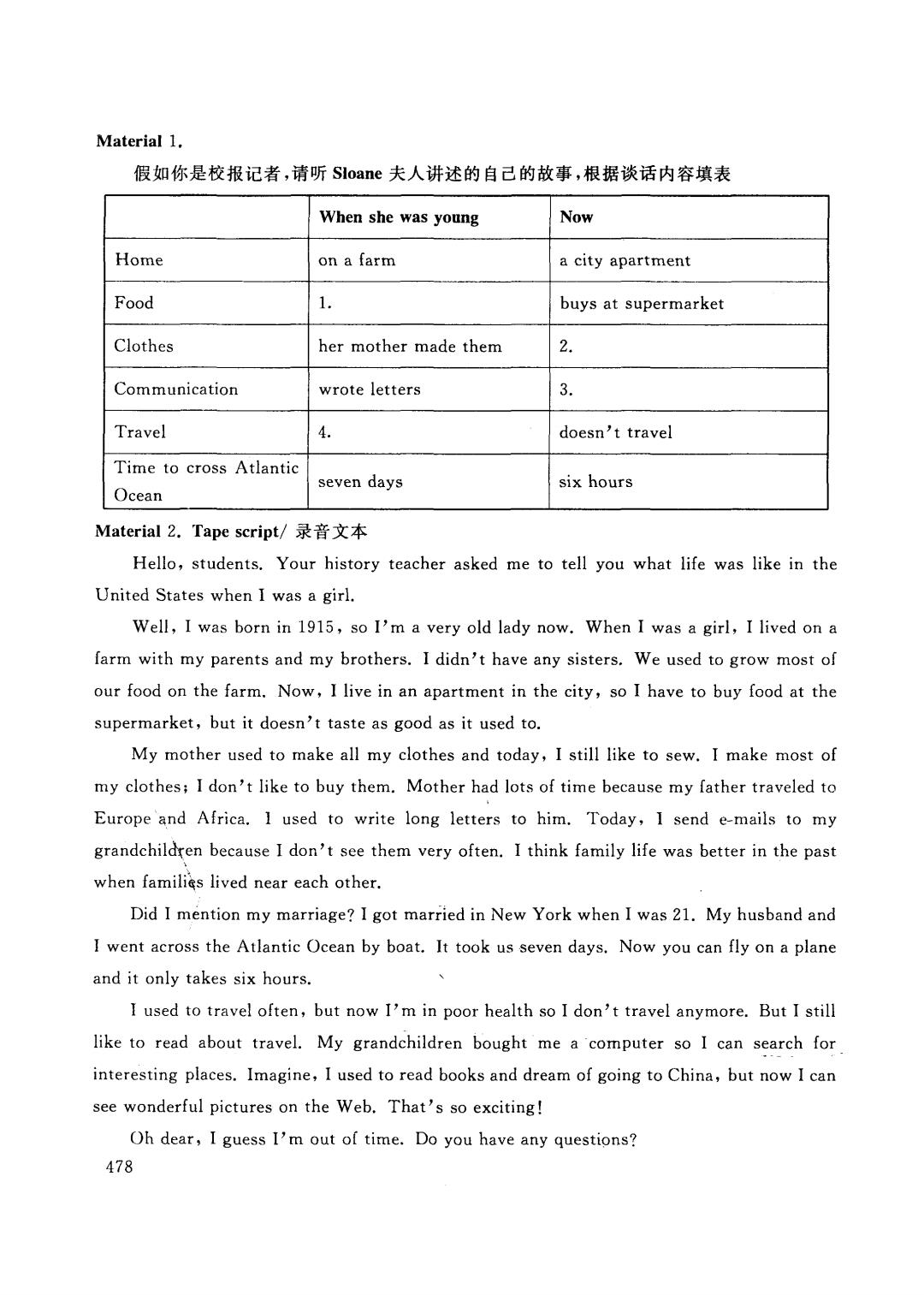
Material 1. 假如你是校报记者,请听Sloane夫人讲述的自己的故事,根据谈话内容填表 When she was young Now Home on a farm a city apartment Food 1. buys at supermarket Clothes her mother made them 2. Communication wrote letters 3. Travel 4. doesn't travel Time to cross Atlantic seven days six hours Ocean Material2.Tape script/,录音文本 Hello,students.Your history teacher asked me to tell you what life was like in the United States when I was a girl. Well,I was born in 1915,so I'm a very old lady now.When I was a girl,I lived on a farm with my parents and my brothers.I didn't have any sisters.We used to grow most of our food on the farm.Now,I live in an apartment in the city,so I have to buy food at the supermarket,but it doesn't taste as good as it used to. My mother used to make all my clothes and today,I still like to sew.I make most of my clothes;I don't like to buy them.Mother had lots of time because my father traveled to Europe and Africa.I used to write long letters to him.Today,I send e-mails to my grandchildren because I don't see them very often.I think family life was better in the past when families lived near each other. Did I mention my marriage?I got married in New York when I was 21.My husband and I went across the Atlantic Ocean by boat.It took us seven days.Now you can fly on a plane and it only takes six hours. I used to travel often,but now I'm in poor health so I don't travel anymore.But I still like to read about travel.My grandchildren bought me a 'computer so I can search for interesting places.Imagine,I used to read books and dream of going to China,but now I can see wonderful pictures on the Web.That's so exciting! Oh dear,I guess I'm out of time.Do you have any questions? 478
\ 岛'1 1. 假如你是校报记者,请昕 oa e夫人讲述的自己的故事,根据谈话内容填表 When she was young Now Home on a farm a city apartm巳nt Food 1. buys at supermarket Clothes her mother made them 2. Communication wrote letters 3. Travel 4. doesn' t travel Time to cross Atlantic seven days six hours Ocean Material 2. Tape script/ 文本 Hello , students. Your history teacher asked me to tell you what life was like in the United States when I was a girl. Well , I was born in 1915 , so I'm a very old lady now. When I was a girl , I lived on a farm with my parents and my brothers. I didn't have any sisters. We used to grow most of our food on the farm. Now , I live in an apartment in the city , so I have to buy food at the supermarket , but it doesn' t taste as good as it used to. My mother used to make all my clothes and today , I still like to sew. I make most of my clothes; I don' t like to buy them. Mother had lots of time because my father traveled to Europe&nd Africa. I used to write long letters to him. Today , I send e-mails to my grandchild扫nb巳cause I don' t see them very often. I think family life was better in the past when famili~s lived near each other. Did I mention my marriage? I got married in New York when I was 21. My husband and I went across the Atlantic Ocean by boat. It took us seven days. Now you can fly on a plane and it only takes six hours. I used to travel often , but now I'm in poor health so I don' t travel anymore. But I still like to read about travel. My grandchildren bought· me acomputer so I can search for interesting places. Imagine , I used to read books and dream of going to China , but now I can see wonderful pictures on the Web. That's so exciting! Oh 巳ar I guess I'm out of time. Do you have any questions? 478

Activity 1 (Pre-listening) Objectives Classroom organization Teaching aid 1. Procedure 2. 3. Transition (how to relate to the following activity) Activity 2 (Listening) Objectives Classroom organization Teaching aid Transition how to relate to the former activity) 1. Procedure 2. 3. Transition (how to relate to the following activity) Activity 3 (Post-listening) Objectives Classroom organization Teaching aid Transition how to relate to the former activity) 1. Procedure 2. 3. Backup plan: (1)Predicted problems. (2)Possible solutions. 479
Activity 1 (Pre-listening) Objectives Classroom organization Teaching aid 1. Procedure 2. 3. Transition (how to relate to the following activity) Activity 2 (Listening) Objectives Classroom organization Teaching aid Transition (how to relate to the former activity) 1. Procedure 2. 3. Transition (how to relate to the following activity) Activity 3 (Post-listening) Objectives Classroom organization Teaching aid Transition (how to relate to φthρ~ former activity) \ 1. " Procedure \ 2. 3. Backup plan: (1) Predicted problems. (2) Possible solutions. 479
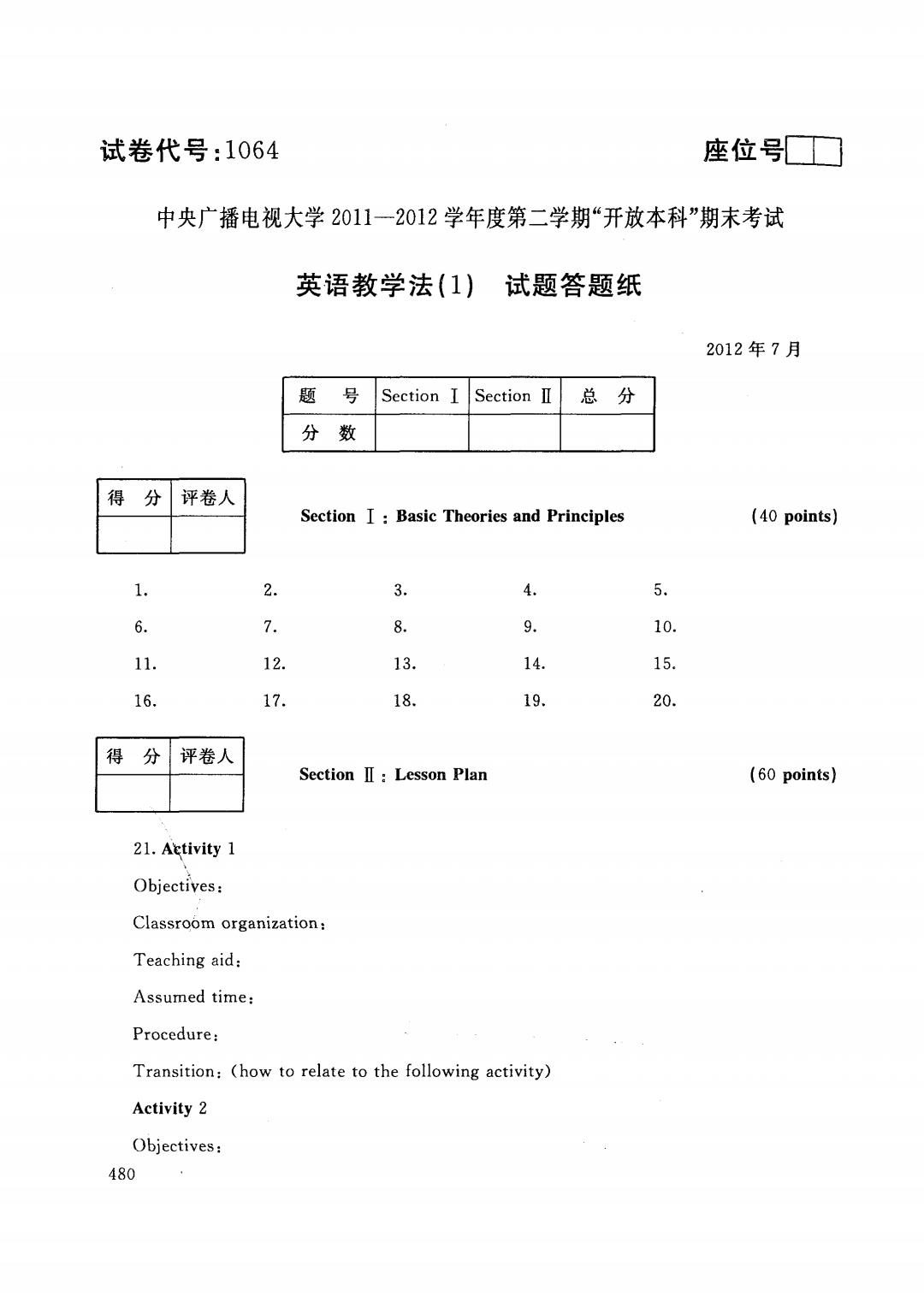
试卷代号:1064 座位号■ 中央广播电视大学2011一2012学年度第二学期“开放本科”期末考试 英语教学法(1) 试题答题纸 2012年7月 题号 Section Section II 总 分 分数 得分 评卷人 Section I Basic Theories and Principles (40 points) 1. 2. 3. 4. 6 6 7. 8. 9 10. 11. 12. 13. 14. 15. 16. 17. 18. 19. 20. 得分 评卷人 SectionⅡ:Lesson Plan (60 points) 21.Aetivity 1 Objectives: Classroom organization: Teaching aid: Assumed time: Procedure: Transition:(how to relate to the following activity) Activity 2 Objectives: 480
试卷代号 4座位号 中央广播电视大学 0 11 2012 学年度第二学 放本科 末考 英语教学法( 1)试题答题纸 2012 年7 Section I Section II ,总 得分|评卷人 Section I : Basic Theories and Principles (40 points) 1. 6. 11. 16. 得分|评卷人 21. A't,tivity 1 Objectives: 2. 7. 12. 17. 3. 8. 13. 18. Section II : Lesson Plan 4. 9. 14. 19. 5. 10. 15. 20. (60 points) Classroom organization: Teaching aid: Assumed time: Procedure: Transition: (how to relate to the following activity) Activity 2 Objectives: 480

Classroom organization: Teaching aid: Assumed time: Transition:(how to relate to the former activity) Procedure: Transition:(how to relate to the following activity) Activity 3 ·Objectives: Classroom organization: Teaching aid: Assumed time: Transition:(how to relate to the former activity) Procedure: Backup plan: (1)Predicted problems (2)Possible solutions 481
Classroom organization: Teaching aid: Assumed time , Transition: (how to relate to the former activity) Procedure , Transition: (how to relate to the following activity) Activity 3 Objectives: Classroom organization: Teaching aid: Assumed time , Transition: (how to relate to the former activity) Procedure: Backup plan: (1) Predicted problems (2)Possible solutions 481

试卷代号:1064 中央广播电视大学2011一2012学年度第二学期“开放本科”期末考试 英语教学法(1) 试题答案及评分标准 (供参考) 2012年7月 Section I Basic Theories and Principles 40 points 本题为单选题,共20个小题,总计40分,每题2分。 1.B 2.A 3.C 4.A 5.B 6.B 7.A 8.A 9.C 10.A 11.C 12.B 13.B 14.C 15.B 16.C 17.C 18.C 19.A 20.A SectionⅡLesson Plan 60 points 21.参考答案和评分标准 Activity 1 (Pre-Listening) Objectives:to lead in the topic and to activate students'background knowledge of interviewing another person. Classroom organization:Group work Teaching aid:pictures Assumed time:5 minutes Procedure (1)Lead-in:introduce the topic (1') The teacher can lead in the topic by asking questions like: "Now,class.Today we are going to listen to something about interviewing people in English.First,what is the first thing that you would ask them?" (2)Group discussion (3') The teacher calls on one or two students to contribute,and then raise another question for group discussion. "OK.What else would you ask them?Work in groups.See if you know anything" 482
试卷代号 中央广播电视大学 11 2012 学年度 未考 英语教学法 试题答案及评分标准 (供参考) 2012 年7 Section I Basic Theories and Principles 40 points 本题为单选题,共 0个小题,总计 0分,每题 2分。 I. B 6. B 11. C 16. C 2. A 7. A 12. B 17. C BC qaoo--14 CA 4. A 9. C 14. C 19. A 5. B 10. A 15. B 20. A Section IT Lesson Plan 60 points 1. 考答 评分 Activity 1 (Pre-Listening) Objectives: to lead in the topic and to activate students' background knowledge of interviewing another person. Classroom organization: Group work Teaching aid: pictures Assumed time: 5 minutes Procedure、§ (1) Le~d-in: ir山oduce the topic (1') The teacher can lead in the topic by asking questions like: "Now , class. Today we are going to listen to something about interviewing people in 、飞 English. First , what is the first thing that you would ask them?" (2)Group discussion (3') teacher calls on one or two students to contribute , and then raise another question for group discussion. "OK. What else would you ask them? Work in groups. See if you know anything" 482
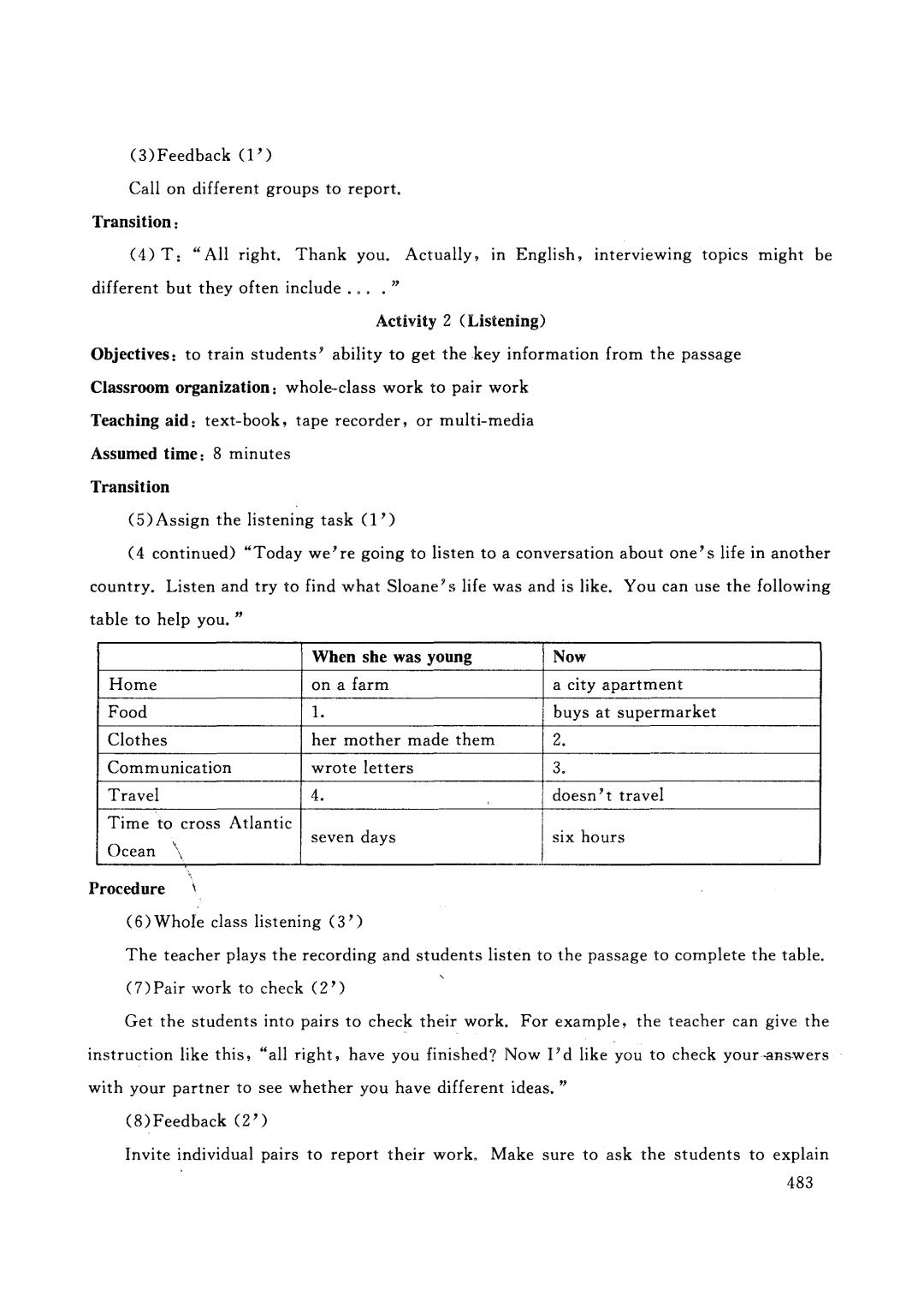
(3)Feedback (1') Call on different groups to report. Transition: (4)T:"All right.Thank you.Actually,in English,interviewing topics might be different but they often include...." Activity 2 (Listening) Objectives:to train students'ability to get the key information from the passage Classroom organization:whole-class work to pair work Teaching aid:text-book,tape recorder,or multi-media Assumed time:8 minutes Transition (5)Assign the listening task (1') (4 continued)"Today we're going to listen to a conversation about one's life in another country.Listen and try to find what Sloane's life was and is like.You can use the following table to help you.” When she was young Now Home on a farm a city apartment Food 1. buys at supermarket Clothes her mother made them 2. Communication wrote letters 3. Travel 4. doesn't travel Time to cross Atlantic seven days six hours Ocean Procedure (6)Whole class listening (3') The teacher plays the recording and students listen to the passage to complete the table. (7)Pair work to check (2') Get the students into pairs to check their work.For example,the teacher can give the instruction like this,"all right,have you finished?Now I'd like you to check your answers with your partner to see whether you have different ideas. (8)Feedback (2') Invite individual pairs to report their work.Make sure to ask the students to explain 483
(3) Feedback (l') Call on different groups to report. Transition , (4) T: "All right. Thank you. Actually. in English. interviewing topics might be different but they often include. .. ." Activity 2 (Listening) Objectives: to train students' ability to get thekey information from the passage Classroom organization: whole-class work to pair work Teaching aid: text-book , tape recorder, or multi-media Assumed time , 8 minutes Transition (5) Assign the listening task (1') (4 continued) "Today we' re going to listen to a conversation about one's life in another country. Listen and try to find what Sloane's life was and is like. You can use the following table to help you. " When she was young Now Home on a farm • a city apartment Food 1. buys at supermarket Clothes her mother made them 2. Communication wrote letters 3. Travel 4. doesn 't travel Time to cross Atlantic seven days six hours Ocean 气\ 飞, Procedure (6) Whole class listening (3') The teacher plays the recording and students listen to the passage to complete the table. (7)Pair work to check (2') Get the students into pairs to check their work. For example , the teacher can give the instruction like this. "all right. have you finished? Now l' d like you to check your -aJlswers with your partner to see whether you have different ideas. " (8)Feedback (2') Invite individual pairs to report their work. Make sure to ask the students to explain 483